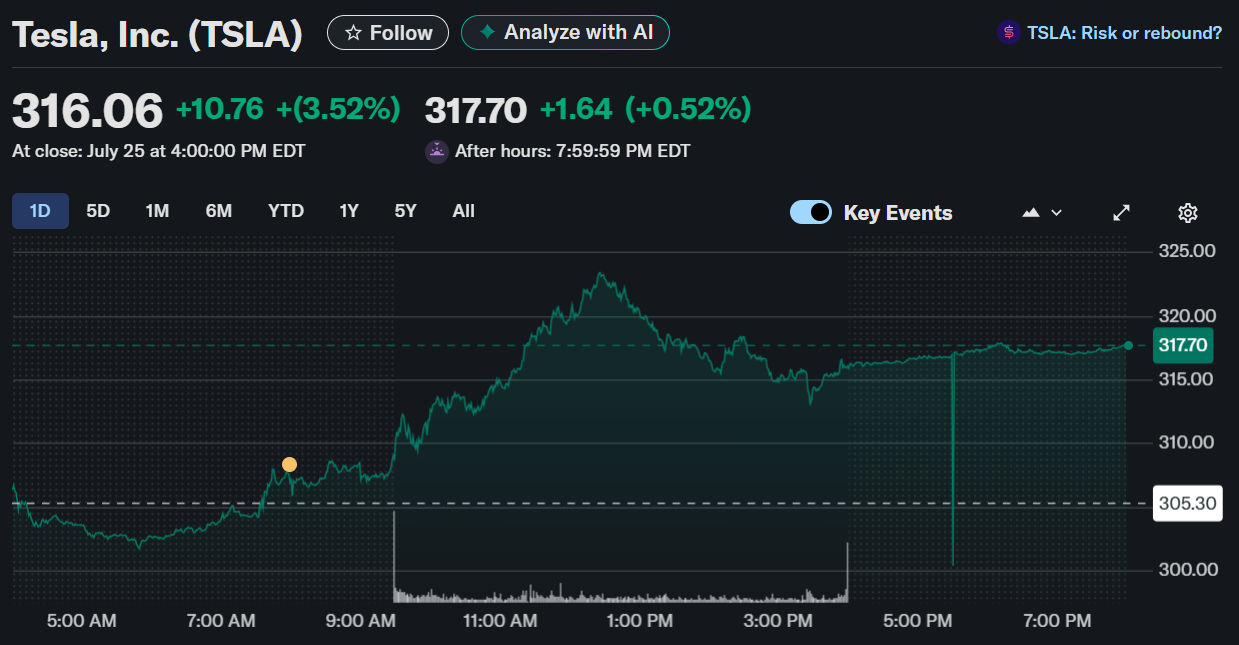Tesla ($TSLA) at a Crossroads: Elon’s Robotaxi Vision Battles Wall Street Skepticism
Elon Musk's audacious robotaxi dream for Tesla is colliding head-on with Wall Street's cold, hard reality checks.
### The Grand Vision vs. The Balance Sheet
While Musk promises self-driving fleets by 2026, analysts see another 'funding secured' moment—TSLA's volatile stock swings suggest investors can't decide whether to bet on Silicon Valley disruption or Detroit-style fundamentals.
### The Cynic's Corner
Nothing boosts a stock like vaporware—until the SEC asks for deliverables. Tesla's 'AI Day' demos dazzle, but can they offset shrinking margins in its actual car business? (Spoiler: Wall Street's betting on 'no.')
TLDR
- TSLA stock down 22% YTD despite robotaxi announcements
- Q2 earnings reveal 16% drop in automotive sales
- Musk’s futuristic vision meets regulatory barriers and skepticism
- Competitors like Waymo lead in driverless miles and permits
- Tesla robotaxi service not yet approved in California
Tesla Inc. (NASDAQ: TSLA) closed at $316.06 on July 25, up 3.5% for the day but still down over 22% for 2025.

Tesla, Inc. (TSLA)
The bounce followed a steep 8% drop after the company’s Q2 earnings failed to meet expectations. Vehicle sales dropped 16% year-over-year, with particular weakness in Europe and California. The company is also facing a decline in regulatory credit revenue due to policy shifts.
Tesla reported its Q2 earnings earlier this week, and CEO Elon Musk doubled down on his long-term vision, including the company’s transition into robotics and AI. But Wall Street analysts remain focused on short-term profitability.
Robotaxi Hype Doesn’t Convince Investors
During the earnings call, Musk touted Tesla’s driverless robotaxi service, currently being tested in Austin, Texas. He said the service could reach half of the U.S. by year-end, contingent on regulatory approval. However, no permits have been granted yet, especially in California, where Tesla has not applied for the necessary authorizations.
Tesla claims its Austin pilot has covered 7,000 miles with a small fleet of 10–20 Model Y vehicles. Each is monitored remotely and carries a human supervisor in the front seat. Still, the robotaxis are limited to roads with a 40 mph speed limit.
Wall Street Calls for Near-Term Growth
Despite Musk’s optimism, Canaccord Genuity analysts stressed that Tesla must improve its P&L performance. “We love robotaxis. And robots,” they wrote. “But we love growth too, in the here and now.” Jefferies described the quarter as “a bit dull,” while Goldman Sachs said the robotaxi project remains small and under-tested.
Regulatory and Competitive Pressures Mount
Tesla’s lack of regulatory traction stands in stark contrast to Alphabet’s Waymo, which has already logged over 100 million autonomous miles and operates across more than 10 cities. Waymo’s success has prompted Alphabet to list revenues from autonomous services in its “Other Bets” category, which brought in $373 million last quarter.
Musk still insists Tesla is leading in real-world AI, claiming it’s “much better than Google by far.” He also declared on X that Tesla will eventually be worth $20 trillion, though the market isn’t reflecting that confidence yet.
TSLA Stock Lags Market and Tech Peers
Tesla’s year-to-date return of -21.74% starkly contrasts with the S&P 500’s 8.62% gain. Over a one-year period, however, TSLA is up 43.5%, though its three-year return lags significantly behind the broader index.
Despite long-term bullishness from some analysts, Tesla’s near-term future hinges on execution, regulatory progress, and a turnaround in EV sales. For now, Wall Street remains skeptical.

